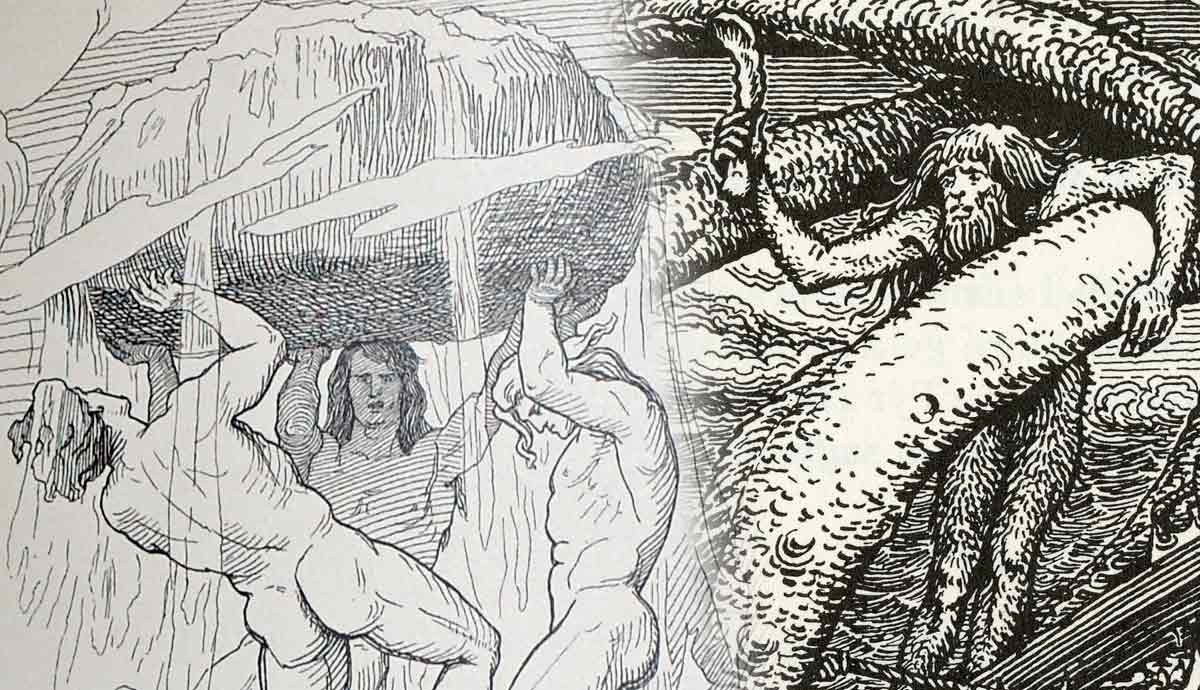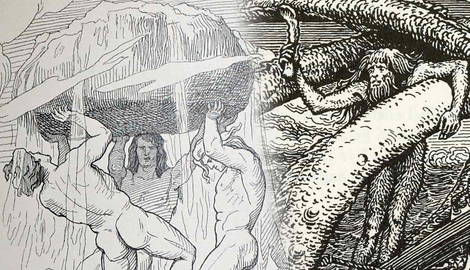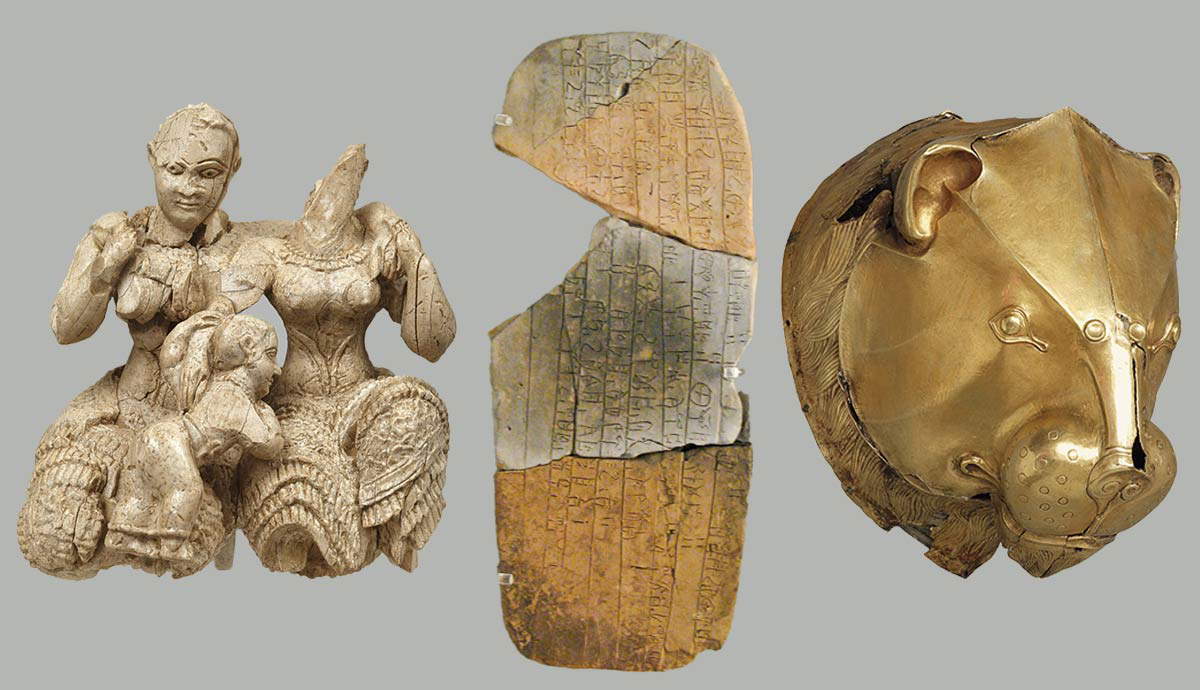
The Vikings conceived of a very different universe centered around the great sacred ash tree Yggdrasil, which held the nine worlds of the Norse cosmos in its roots and branches. But where did the Vikings think that the worlds came from?
The Viking creation myth describes a universe that emerges from primordial goop, and which is then shaped by cooperation and conflict between the gods and the giants. These same forces will eventually destroy the universe at Ragnarök. This is the Norse creation myth.
The Ginnungagap

According to the Norse creation myth, at the beginning of time, existence was dominated by a massive void known as the Ginnungagap. This name means “yawning void” or “magical void” in Old Norse. According to the Voluspa, at the start of time: “there was no sand, nor sea, nor cool waves, no earth nor sky, no grass, only Ginnungagap.”
That said, while the void was large, it had limits. At one end of the void was a world of heat and fire known as Muspelheim, At the other end of the void was a world of cold and mist called Niflheim.
Over time, a collection of rivers known as the Elivagar started to flow up into the void from Niflheim. These rivers carried with them a poisonous substance that hardened and turned into ice in the void. The ice emitted a poisonous vapor that solidified into a solid salty rime, which was constantly growing and filling up the void.
At the same time, hot winds from Muspelheim were also reaching out into the void. Eventually, as the heat and the ice grew closer and closer, the heat melted some of the solid salty rime, creating a primordial ooze.
The First Living Beings

The first living beings in the cosmos emerged from the primordial ooze. The very first being was not a god, but rather a giant, Ymir, also known as Aurgelmir. With a hermaphroditic body, he was able to give birth to the race of giants, with male and female giants emerging from his body, springing from the sweat of his armpits. While most of his children were humanoid, some were also described as hideous monsters, such as a six-headed beast.
Ymir nourished himself on the milk of the primordial cow Audumbla, who also seems to have emerged from the primordial goop. As Ymir was feeding on Audumbla, she was sustaining herself by licking away at what was left of the solid salty rime.
Over the course of three days, Audumbla licked a being called Buri out of the salt rime. His hair emerged on the first day, his head on the second, and the rest of his body on the third day. The first of the gods, he emerged beautiful and strong, and like Ymir, started to create life.
By some unknown method, Buri gave birth to Borr, who would mate with the giantess Bestla and give birth to three sons, the gods Odin, Vili, and Ve.
Origins of Yggdrasil

While the origins of the Yggdrasil tree aren’t specifically noted in any of the surviving myths, it probably also grew out of the primordial goop of the universe. Yggdrasil is a mighty ash tree that is the backbone of the universe. Its roots are in Niflheim and they are fed by three wells: the well of destiny Urdarbrunnr, the well of wisdom Mimisbrunnr, and the well of fire Hvergelmir.
Yggdrasil seems to have created a breeding ground for a variety of animals. In addition to Audumbla, a serpent dragon called Nidhogg lived in Niflheim among the roots of Yggdrasil, which he gnaws on constantly. Meanwhile, an enormous eagle with a hawk perched between its eyes lives at the very top of the tree.
A squirrel called Ratatoskr runs up and down the tree, carrying messages between the dragon and the eagle, who are mortal enemies. Four harts or stags also chomp on Yggdrasil’s leaves and branches, and morning dew forms on their horns, which feeds Yggdrasil’s wells and rivers.
But the four stags do not seem to be friends of the tree. They are called Dainn, “dead one,” Dvalinn, “unconscious one,” Duneyrr, “thundering in the ear,” and Durathror, “thriving slumber.” Yggdrasil, constantly being gnawed and eaten, is described as being in more pain than any man can imagine.
The Murder of Ymir

It seems that for some time the world was then occupied by gods, giants, and other primordial beings. But, over time, Odin and his brothers began to grow concerned about the number of giants that were coming into existence. Ymir’s asexual reproduction meant that giants (or jotun) were quickly outnumbering the gods.
To deal with the threat, Odin and his brothers killed Ymir. His body expelled so much blood that it created an enormous flood that killed almost all the existing giants, greatly limiting their numbers and offering a unique spin on the flood myth.

Odin and his brothers then used the body of Ymir to create the “Earth,” located in the very middle of Yggdrasil. They used Ymir’s blood to make the sea, his body, and bones to make the land and mountains, and they hung his skull over the new world as the sky. The brothers then took sparks and flashes from Muspelheim and placed them within Ymir’s skull to create the stars and used the remaining brains of the giant to make the clouds.
What they created, in the end, was a circular disk. They gave the land on the outskirts to the giants as a place to live. A desolate land, it became known as Jotunheim. The fertile inner land became known as Midgard, literally Middle Earth, and they separated it from Jotunheim, using Ymir’s eyelashes to create a fence. Odin and his brothers then created mankind to populate their new world.
The first man and woman were called Ask and Embla, whose names mean ash tree and vine. Initially lifeless, they were given tree gifts by three different gods to bring them to life. Odin gave them souls, Hoenir gave them senses, and Lothur gave them blood’s heat and a godly hue. They would become the progenitors of all humanity.
Formation of the Worlds

This section of the creation myth explains the creation of Midgard and Asgard, but these were only two of the nine worlds in the Norse cosmos, which were tucked into the roots and branches of Yggdrasil.
Both Niflheim and Muspelheim also already existed. But, at this time, the gods also appear to have closed Muspelheim, trapping the fire giants in this realm. This was a separate group of giants to those living in Jotunheim, sometimes called frost giants to differentiate them. This was probably another step taken to protect mankind from the giants.
Meanwhile, Niflheim was occupied by various creatures. In addition to Niddhog, the Norns—the Norse fates—lived in Niflheim at the Well of Destiny. Later, Odin would install his friend Mimir in Niflheim at the Well of Wisdom. But one of several underworlds was also placed in Niflheim. It is possible that it was created following the death of Ymir, as an underworld for the first giants who died. It would later be known as Helheim.

At the same time, one tribe of gods, led by Odin and known as the Aesir, decided to make their home in a realm closer to the top of Yggdrasil which became known as Asgard. Meanwhile, another tribe of gods, known as the Vanir, would make their home in Vanaheim. It is possible that these were the children of one of Odin’s brothers.
The Aesir and the Vanir would go to war near the beginning of time but would form a peace agreement. This included the exchange of hostages that resulted in several important Vanir gods taking up residence in Asgard, including the Vanir twins Freyja and Freyr. After the war, the Aesir would build fortifications around Asgard to protect them from the giants rather than the Vanir. They also connected Asgard to Midgard via the Rainbow Bifrost Bridge so that they could protect mankind.
It is not recorded anywhere how the other realms of the Norse cosmos were created. But the elves had a home called Alfheim. The elves were sometimes treated as gods, and sometimes as divine ancestors, and may have been the children of another of Odin’s brothers.
The dark elves, more commonly called dwarves, settled in a dark underground world called Svartalfheim. There they became the master craftsmen of the Norse cosmos making most of the treasures that appear in the Norse legends, including Thor’s hammer Mjolnir.
Shaping the Universe

While the Norse cosmos was essentially shaped following the creation of Midgard, the gods did a few other important things that would add to the nature of existence.
First, the god Heimdall visited the world of men to define social order. He spent a night with a poor and ugly couple, ensuring that they had children who would become thralls and slaves in Viking society. He then spent a night with a middle-class couple and ensured that they had children who would become farmers, smiths, and other workers. Finally, he visited an attractive and wealthy couple and ensured that they had children who would be earls and kings. He even fostered one of their children and taught them how to conquer new lands.
Second, the gods learned that Loki had had three children with the giantess Angrboda. The gods decided that the offspring of such a monstrous union were too dangerous to be left to their own devices. They decided to place each somewhere in the universe where they could do the least harm.
Hel was a giantess born half-living and half-dead. She was sent to be the ruler of the underworld Helheim in Niflheim. This was not the only underworld in the Norse cosmos. Odin took brave fallen warriors to live in his hall Valhalla in Asgard, while Freyja also chose brave fallen warriors to live in Folkvangr, which means field of warriors. There was an underwater underworld called Ran for those who died at sea. Many dead were also believed to live in Helgafjell, which means holy mountain.

Fenrir was a giant wolf and the gods tricked him into letting himself be chained up on a deserted island. He gnashed and growled when he realized that he had been tricked, so the gods placed a sword in his mouth to wedge it open. The drool from his mouth created an enormous river called Expectation.
The third child, a serpent Jormungandr, was thrown into the waters surrounding Midgard. There he grew to such an enormous size that he could encircle the whole world and hold his tail in his mouth. His size makes him part of the ecosystem, and his movements can cause tidal waves.
While the banishment of Loki’s children was in some ways an act of creation that made the world the way it is, these acts also created the prerequisite conditions for Ragnarök. The word Ragnarök means the twilight of the gods and is a prophecy that records the death of all the gods and the destruction of the universe.










